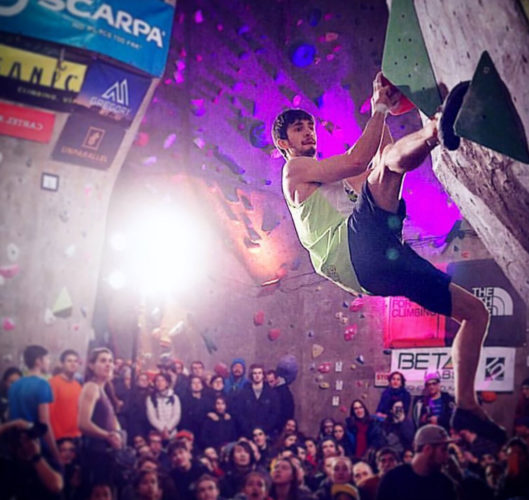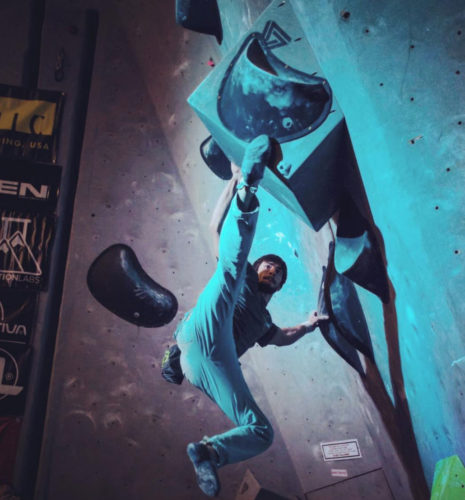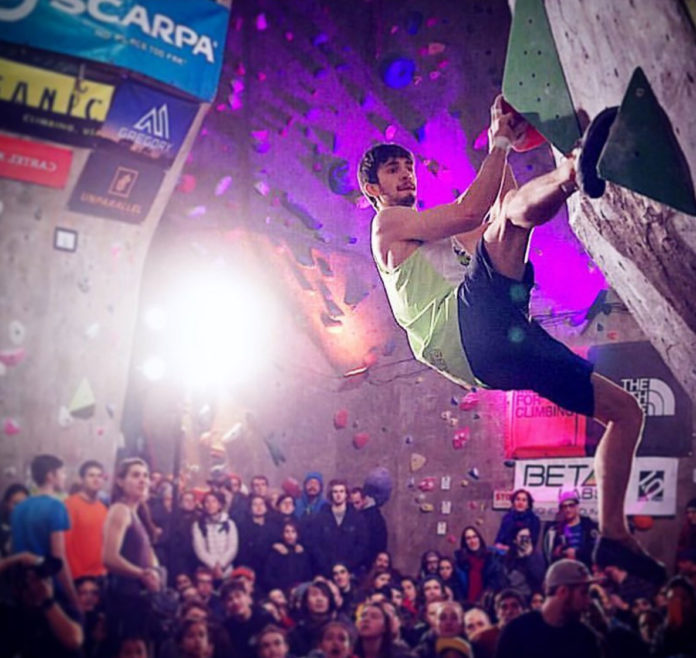
Name: Charlie Schreiber
Occupation: Director of Programming at Reach Climbing + Fitness
Location: Bridgeport, Pennsylvania
Behind the Desk is a series that interviews people who are part of the climbing industry—whether managing the gyms, inspiring their colleagues, owning interesting companies, or implementing innovative ideas. This week, we’re spotlighting Charlie Schreiber, who you may have heard co-commentating USAC’s Collegiate Nationals last month.
Originally from Woodcliff Lake, New Jersey, Schreiber was a devoted skateboarder as a child—until his local skatepark was abruptly turned into a climbing gym. Despite the initial shock at the facility’s makeover, Schreiber—13 years old at the time—decided to give climbing a try and was instantly hooked. He soon joined the youth climbing team of Gravity Vault in Upper Saddle River, New Jersey, and started routesetting and coaching. This evolved into helping with the opening of another gym in the area, High Exposure. Schreiber explains, “I was a 20-year-old kid that opened a gym and developed successful programs, so word started to spread; over the next four years, I would compete in several World Cups, write a guidebook for the Powerlines Bouldering, coach my team to become Regionals and Divisionals Champions (they all started as day-one climbers with me), create a National Champion (Adam Shahar) and the most avid first-ascensionist of the East Coast (Austin Hoyt).”
Word continued to spread, which eventually led to Schreiber working with yet another gym—Reach Climbing + Fitness—in a similarly multi-faceted way. Shreiber says, “I did the same thing for Reach that I did for High Exposure.” Now 28 years old, Shreiber serves as the head coach of Reach Climbing’s youth team, as well as the gym’s Director of Programming. And that’s precisely where our interview begins…
BURGMAN: Let’s talk more about the Director of Programming position. It’s not a position that every climbing gym has, so please sell me on it. In your opinion, is it a position that every climbing gym should have?
SCHREIBER: The Director of Programming position is absolutely crucial for success. It is the director’s job to create, write curriculum for, do the scheduling for, and organize all programs that occur at the facility. Think about all the classes your gym offers. Now, consider that a Program Director would be able to introduce new types of programming for kids and could spearhead new types of events as well. I have created an entire department of Ninja Warrior Classes, Mentor and Me classes, and Karate Classes. In addition, I put on 4-6 camps a year, and manage and organize five different climbing and ninja teams.

That’s quite a list of program offerings. So, how much of your job is utilizing the time-honored gym programs like competitions and classes, and how much is thinking outside the box and creating totally new programming?
I would have to say that it’s half and half. I get my new ideas from think-tank sessions with our management team, exploring other local businesses that cater to children of the ages we are looking to add programing for, as well as talking with parents and potential coaches to see what people have the abilities to teach (or already do somewhere else), and to see what parents have their kids doing at other locations. I know parents like to keep costs down, and if we can offer other classes they are already participating in and offer it as a smaller ‘add-on’ fee, it will help us and help them.
One of the biggest topics of the past couple years has been COVID. How is a Director of Programming job at a gym different now than it would have been, say, five years ago?
One thing that changed for me is I had to create and enforce strict mask policies at my facility. In addition, since COVID, staffing has gotten much more difficult. We have had a tough time getting quality coaches and front desk staff to stay.
When you say you’ve had a tough time getting quality coaches and front desk staff to stay, is there any strategy that has worked for you?
I know that social media posts, as well as Indeed.com ads, have brought us the most applicants. I also ask our existing staff (non-coaches) if they would be interested in coaching and many seem to rise to the occasion. I believe that this deeper level of involvement with the company aids in keeping them employed here. However, I know that the biggest factors for employee retention have been: upward mobility, more hours and higher pay. Therefore, I let our coaches know about the upward mobility they can achieve during the interview and explain to them that they will receive raises frequently if they perform well and are consistently good about communication and being punctual…and have good attendance. I then honor my word and offer raises annually and sometimes twice annually.
Business owners and entrepreneurs often talk about their ‘business philosophy.’ Let’s apply that to climbing gym programming. What’s your ‘programming philosophy?’
My philosophy is: Offer the best possible programs you can in which the customers have as much fun as possible—and achieve whatever it is they want to get out of the class while always feeling safe. Also, find the best, motivated coaches that make people smile and know their craft well and love it. And always be open to new ideas.

Are there any areas of programming that you think other gyms struggle with? And, to that point, what are the biggest challenges of being a Director or Programming?
I think a lot of gyms struggle with creating new and unique programs that keep up with trends. I also think that many gyms under-appreciate their climbing teams and don’t give them the support that they need. There is a way to support your team and, at the same time, support your members.
The biggest challenge of being a program director is scheduling staff and finding coverages. Sometimes I will have 15 coaches working on a given weekend and two will tell me they got sick a day before. Those moments of scrambling to find coverage are always thrilling.
So, in your opinion, how does someone get good at being a Director of Programming at a gym? Your keys to success, basically.
- Be Organized. Create spreadsheets that have all of the information you need for managing classes.
- Keep a pulse on the community. I am in the gym for about 50 hours per week. I talk with all the members and keep in touch with parents of class-goers. They will tell you what programs they want.
- Learn from mistakes and be patient. The gym owner and my boss, Mike Feinberg, has been very patient with me—as I have made many small mistakes along the way. We always have brief meetings about what I can do to be better in the future, and I always write down the takeaways at the top of my to-do list—that way I see them all day, every day. I learn and improve quickly that way.
- Always ask yourself, ‘What would be freakin’ awesome?’ If you can’t come up with anything, ask people. Your goal is always to bring something fun to the people. That’s why we climb and sign-up for classes. Read about new ideas and search the web. There are a million ideas out there.

John Burgman is the author of High Drama, a book that chronicles the history of American competition climbing. He is a Fulbright journalism grant recipient and a former magazine editor. He holds a master’s degree from New York University and bachelor’s degree from Miami University. In addition to writing, he coaches a youth bouldering team. Follow him on Twitter @John_Burgman and Instagram @jbclimbs. Read our interview Meet John Burgman, U.S. Comp Climbing’s Top Journalist.









